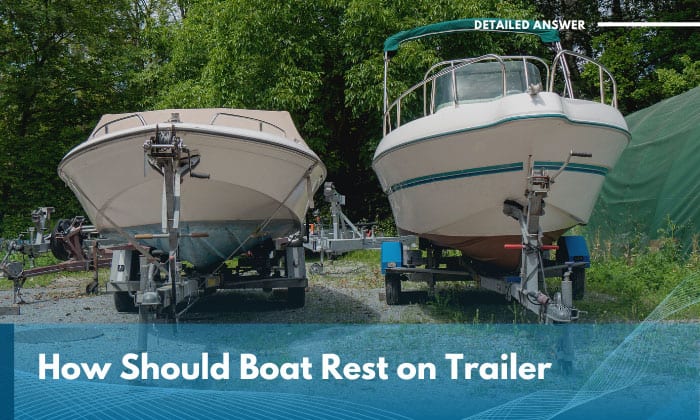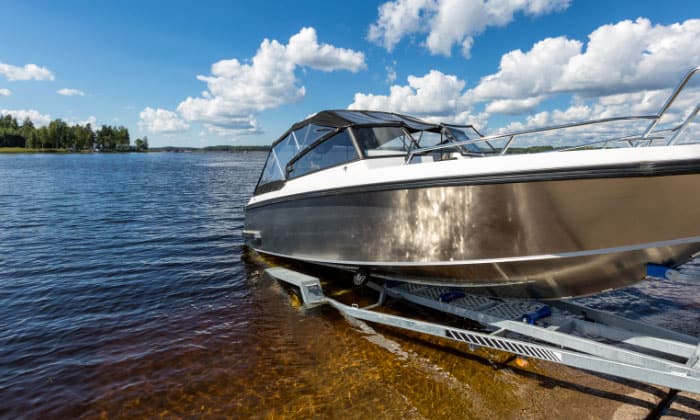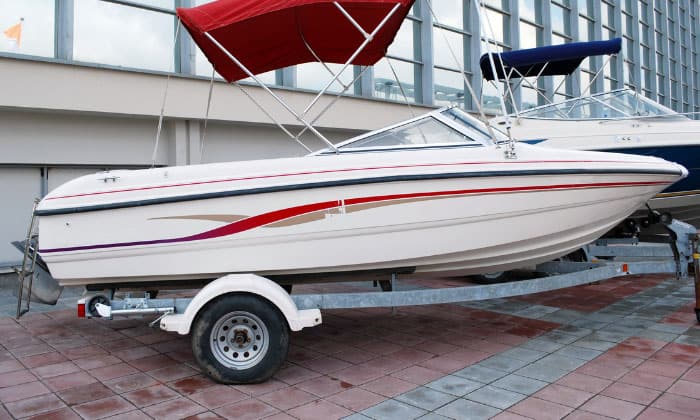“How should boat rest on trailer?” is a question related to one fundamental skill every watercraft owner should have: securing a boat to a trailer.
The thing is, there are many factors to consider here, as there are different types of trailers, boats, and bunk setups. At best, you need to keep the boat level or centered on the trailer, with the axles and rear bunks bearing most of the weight.
Matching your boat’s size with a trailer with the correct capacity and bunk patterns should make this close to automatic.
Table of Contents
How Should the Trailer Cradle a Boat?
When trailering boat, you have to get the weight right. Position it in such a way that the axles will bear most of the weight and keep it balanced all throughout. As you do so, always consider the tongue weight, which shouldn’t exceed 15% of the total load weight at most.
When I said that the boat on a trailer should be centered, I meant you should pay attention to how it’s positioned from side to side. Is one side poking out more prominently than the other?
If yes, that’s where optimal boat trailer bow support should be provided, particularly with the use of the most suitable side and rear bunks or pads.
Moreover, there should be no risk of the gel coat wearing out or any other damage being inflicted on your vessel (or yourself) when boat loading and trailering. Using the correct number of bunks that fit the shape of your vessel’s hull should erase this risk.
After you load boat on the trailer and secure it, before you start driving, I also suggest you make sure that the trailer is level with the ground. That practice alone goes a long way in keeping the load minimal on your tires and aids in fuel efficiency.
Here are some other tips and helpful information to keep in mind when considering your boat’s placement on the trailer:
- The ideal setup for most boats is for the majority of the weight to be placed on the axles. This is why most center console trailers are set up in such a way that there are noticeably bigger support bunks at the rear and only small guides in front.
- You may be dealing with too much tongue weight if you’re feeling too much heft at the trailer’s front.
- You can let the boat rest on keel roller, but it should only bear a minimal amount of the boat’s entire weight while you’re trailering.
- Also, don’t adjust boat trailer keel rollers just to make them touch (i.e. support) the hull more.
- The same goes for any guide (forward) bunks found on your trailer. As their name practically announces, they’re only there to guide and not bear the brunt of the trailer’s weight.
- You can help a certain trailer to fit the boat. To do so, you need to properly adjust the bunks on a boat trailer.
How to Rest a Boat on Trailer
On the whole, this topic is related to proper boat trailer loading. Take note that with the proper trailer setup, your boat should automatically center and correctly rest on the trailer once you drive it up the bunks.
First, attach the winch strap to the bow of the boat, followed by the safety chains. Then, all you need to do is drive the boat up the trailer.
At best, you don’t even have to worry about it not centering as you load it, as once you hit the road, it’s likely to do so once you encounter your first hump automatically! Just make sure ⅔ of the rollers or bunks are in the water first.
This video provides a good visual reference of this basic process:
How Do I Know if My Boat is in the Correct Location of the Trailer?
At best, a boat that isn’t centered is fairly obvious in most trailer bunk setups. As I’ve explained above, the parts that should carry most of the heft should readily give you clues about how boats should be positioned on the trailer.
After putting the boat on the trailer, the sides shouldn’t be tilted, unlike how a troubled ship does a starboard or port list at sea.
Once you let the boat be on the trailer (i.e. it’s seated on it), the boat trailer keel guide should be more elevated at the front as this also makes unloading easier. A 1-2 inches height difference between the front and back should suffice.
As for the allowed overhang at the rear, you can position the boat by at most 2 inches over the keel roller closest to the back, assuming that’s how your trailer is set up. The winch post should still be able to easily secure the boat once seated.
Lastly, the side bunks should be making contact with the hull, but only to make sure that the boat won’t be rocked or moved to and fro once you’re on the road.
Check Out the Trailer’s Additional Safety Features
- Learn how a trailer’s breakaway cable works. Be sure to have it inspected and maintained regularly as it’s your number-one safety option in the event of an emergency while trailering.
- Adding a boat trailer bow rest, assuming it’s not included in the trailer, will give more support and stability. This item is highly adjustable and can also help every time you drive boat onto trailer, especially if your ramp has a weird angle.
- A trailer with a self centering roller helps tremendously for those struggling to keep their vessels level.
- Learn how to adjust boat trailer winch post properly so that it will cradle your boat better.
Wheel & Trailer Tire Condition
They should be aired up properly, not only to keep you safe while on the road but to keep the boat level, too. Check the tire’s pressure regularly.
The recommended PSI is printed on the tire itself, so be sure to check every wheel on your trailer. Don’t go above that limit!
Finally, find the time to look for evident signs of wearing out on the bearing protectors, wheels, and tires. Replace them if cleaning and maintenance don’t work anymore.
Conclusion
So how should boat rest on trailer? It should be centered, with most of the weight concentrated at the areas and portions of the trailer I’ve explained above. These are the general rules for most types of trailers, assuming the boat is matched with the correct trailer already and has the right tongue weight.
If you have any doubts or want to confirm the information shared here, I highly encourage you to pay a visit to your local dealer and ask them to double-check and make the correct adjustments if necessary.

“My intention from the first day establishing Boating Basics Online is to provide as much help as possible for boaters who want to experience a first safe and convenient trip. So feel free to join us and share your beautiful journeys to the sea!”



